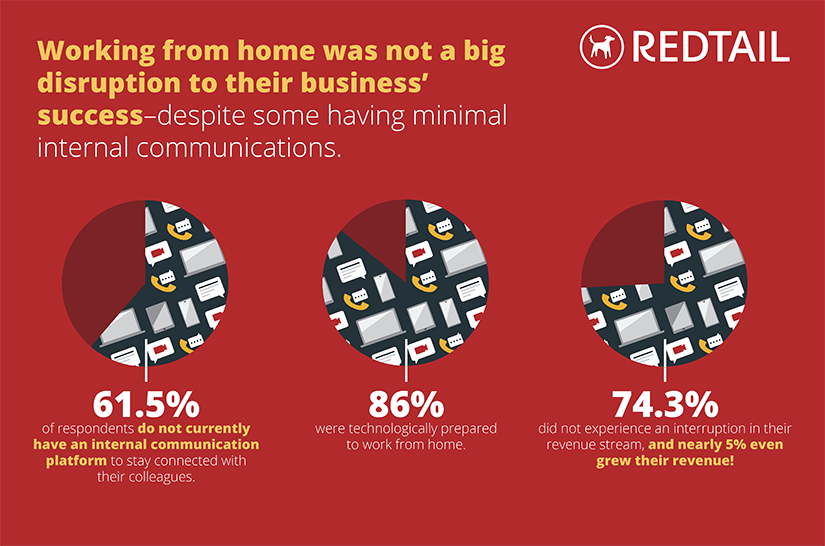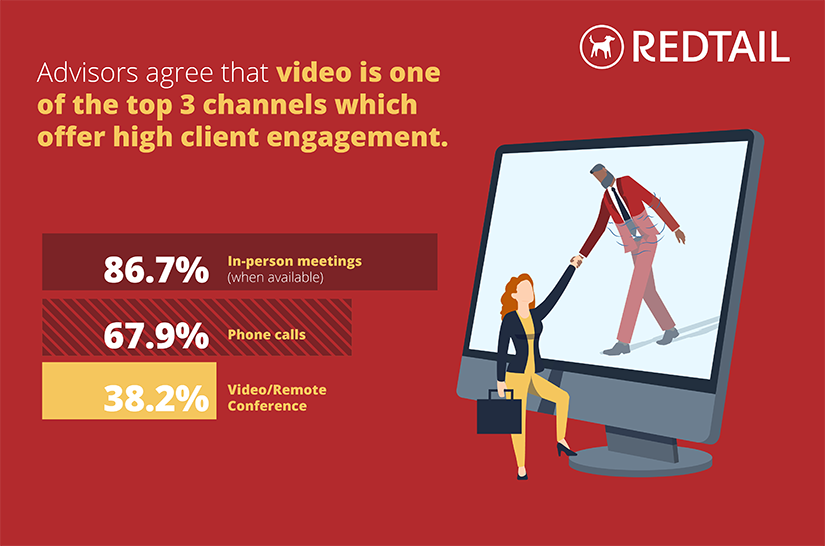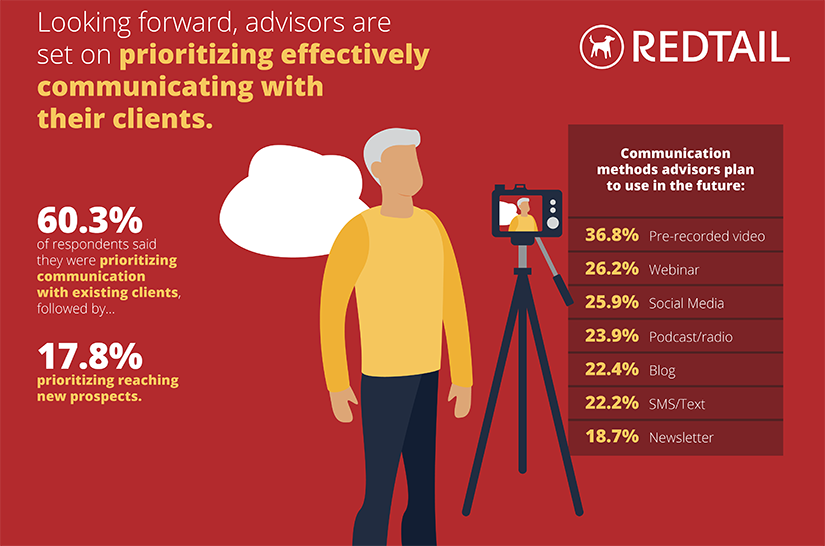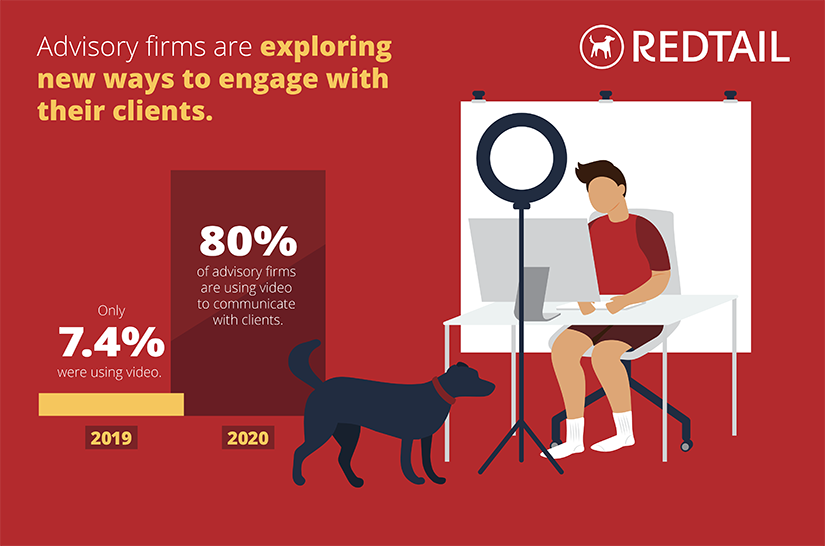ABOUT THE SURVEY:
In July of 2020, Redtail Technology conducted the “Working Remotely” survey to learn more about how financial advisors and their staffs adapted to remote work environments, how this affected their client engagement strategies, and which communication channels proved most effective when working in virtual environments.
Based on data collected from the survey, Redtail set out to understand:
- How effectively wealth management professionals were able to transition to remote-only work environments and avoid or minimize business disruption
- What this might mean for the future in terms of remote work vs. office-only practices (or some hybrid of the two)
- Which technologies helped offices maintain regular client communication/engagement and which may now be considered more seriously for future adoption
METHODOLOGY:
Redtail surveyed more than 1,750 wealth management employees across the United States, whose firms’ managed client assets ranged from under $500 million to more than $1 billion. Among the respondents, the breakdown of roles was as follows:
- 40.8% financial advisors
- 18.7% client services
- 17.9% administrative employees
- 9.2% executive management
- 8.8% operations
To compare and contrast advisor work from home patterns before and after COVID-19, respondents were asked how frequently they worked remotely in 2019:
- Never or very rarely: 50.4%
- 1-2 times per month: 16.3%
- Full-time (more than 4 days a week): 13.3%
- 2-3 days per week: 10.4%
- Once per week: 9.6%
KEY FINDINGS:
While much of the world was required to work from home, financial services proved to be particularly resilient in terms of adapting and continuing to meet client expectations and business needs:
“While our industry has historically been an in-person business, we have all seen that technology has enabled us to work from home while staying connected with clients and to continue business as usual, though there were challenges associated with the transition.” – Survey respondent
- COVID-19 has shifted the work from home mindset of advisory firm employees across the country. In 2019, two-thirds (66.7%) of respondents never or rarely worked from home, and in 2020 respondents did a complete flip – 64.7% believe they will work from home at least one day a week in the future.

- The majority of respondents (62.3%) appreciated the zero-commute time, and nearly half enjoyed the flexible schedule (47.9%); still, the overwhelming majority (73.3%) anticipate keeping their office space.
- Many respondents experienced challenges while working from home. 43.5% experienced social isolation or disconnect from co-workers, and 41.7% dealt with family distractions. And, while the majority of respondents were prepared for the shift to work remotely, 35.2% cited a lack of office supplies as a challenge.
Working from home was not a big disruption to the success of their businesses.
- Despite the fact that in 2019 half of respondents surveyed never or rarely worked from home, 86% of respondents said that in 2020 they ranged from somewhat to very prepared with the proper technology for a seamless transition. However, there was one technology where firms were less prepared to transition to work from home: 61.5% currently have no internal communication platform geared toward staying connected with their colleagues.
- A vast majority of respondents (74.3%) did not experience an interruption of their revenue stream by working from home, and nearly 5% of respondents actually grew their revenue!

While traditional modes of client engagement and communication retained their importance, advisors did express a willingness to further explore new communication channels moving forward:
“In-person” connection continues to be the preferred choice for client engagement, as well as for onboarding and training new employees. To offset the limitations of virtual relationship building, advisors recognize the increased need for customized communications for clients. They are exploring new ways to reach them (video, webinar, social media, podcast/radio, blog):
- Wealth management employees value in-person meetings the most to generate client engagement. Given the restrictions due to COVID-19, they have heavily relied on phone and email to connect and are focused on producing customized communications to reach different clients.
- This year’s top communication challenges have not shifted since last year, despite the pandemic:
1. Customizing content for different audiences (50.8% in 2020; 45% in 2019)
2. Engaging with clients outside of meetings (45.6% in 2020; 40% in 2019)
3. Producing unique content (29.8% in 2020; 30% in 2019) - 80% of respondents are using video/remote conference as a method of client communication in 2020. Respondents also agree that it is one of the channels with the highest client engagement (38.2%) – third only to phone calls (67.9%) and in-person meetings, when they are an option (86.7%).
— This is a vast increase from 2019, where only 7% of respondents were using video to connect with clients on a regular basis.

- Advisors plan to prioritize more effective communication moving forward, with 60.3% focusing on existing clients and 17.8% targeting new prospects. Additionally, significant percentages plan on adding communication channels they haven’t prioritized in the past:
⁃ Pre-recorded video (36.8%)
⁃ Webinar (26.2%)
⁃ Social Media (25.9%)
⁃ Podcast/radio (23.9%)
⁃ Blog (22.4%)
⁃ SMS/Text (22.2%)
⁃ Newsletter (18.7%)

FURTHER ANALYSIS:
Technology for work-from-home generally allowed for business as usual for most respondents.
2020 was a pivotal year for the financial advice industry. While the technologies that enable remote work have been around for years, 2020 has proven to be, by necessity, the year when these technologies were first truly put to the test in that regard in any widespread way.
While working from home posed its own set of challenges for many respondents in terms of client engagement, culture, and distractions, the vast majority were at the very least somewhat prepared to make the transition because of their existing technologies and infrastructure, as evidenced by the below survey question and responses:
Before COVID-19, how prepared were you with the technology/infrastructure in place to enable a seamless work from home experience?
• Very prepared – 32.3%
• Adequately prepared – 27.8%
• Somewhat prepared – 26%
• Not prepared at all – 7.6%
• N/A: I continued to work in the office as normal – 4.9%
The 86% of respondents indicating they were somewhat, adequately, or very prepared for a seamless work from home experience tracks closely with respondents’ answers on whether or not their revenue stream was affected by working from home, with 74.3% indicating their revenue stream was not impacted, and nearly 5% indicating growth in revenue during this period.
Communication preferences (and challenges) have remained largely the same, but preferences gave way to necessity.
As mentioned above, nearly 87% of respondents believe an in-person meeting generates the most engagement with their clients. No surprises there, and it’s likely in-person meetings will remain the most valued communication channel for the foreseeable future.
Still, the jump in usage of video conferences to connect with clients between our 2019 and 2020 studies (from 7% to 80%) was dramatic.

Considering the massive shift in communication channels that respondents were largely forced into this year, one of our survey’s more surprising findings was that their top communication challenges remained largely unchanged. In other words, they may still prefer face-to-face meetings over virtual meetings, but the fact that a huge number of their client meetings were held virtually this year didn’t dislodge or change what they viewed as their biggest communication hurdles, i.e., customizing content for different audiences, engaging with clients outside of meetings, and producing unique content. This likely accounts for the survey’s findings of an increased willingness on the part of firms to explore new channels of client engagement such as pre-recorded videos, webinars, social media, podcasting, etc.
CONCLUSION:
If there was one stat that jumped out perhaps more than any other, it was the shift in perceptions about working from home. In 2019, two-thirds of respondents never or very rarely worked from home, compared with the two-thirds in 2020, who expect that they will work from home at least one day a week moving forward. They loved work from home benefits such as zero commute time, greater flexibility, and more time with family.
On the other hand, social isolation, family distractions, and a lack of office supplies were mentioned by many as challenges they experienced while working virtually.
In the end, technology made the transition to home environments possible, and survey respondents appeared to embrace the idea of shifting at least part of their work schedule to a virtual environment in the future, despite having challenges that they will have to navigate to do so.
“It’s hard to imagine a year with more disruption than what we’ve witnessed in 2020; this leads to a degree of caution when analyzing responses provided while the disruption is ongoing.
Still, there are some conclusions we can draw based both in relation to what our respondents told us and on our own lived experience during this pandemic. We all had to adapt without warning to working full-time in environments that we never envisioned as our primary workspace. To one degree or another, we all had to deal with technology issues that we weren’t used to dealing with. And, I believe that many of us will come out the other side of this with a deeper understanding than before that authenticity, rather than the ability to conduct a flawless Zoom meeting, will win the day in terms of forging stronger relationships with our clients and prospects. Hopefully, this will also lead to advisors moving beyond curiosity about some of the communication channels they aren’t currently using to an exploration of them to see which ones will help them meet the communication challenges that appear to remain constant from year to year.
As I mentioned above, I’m hesitant to make big predictions for the future, particularly about what we considered the most surprising finding in the survey: two-thirds of respondents expect to be working from home at least one day a week in the future. Still, if you’re the one responsible for making the decision about how often, if ever, your employees will be able to work from home after all this is over, you’ve certainly got to balance employee expectations against the pros and cons involved. Perhaps one potential positive to come out of all of this will be forward-thinking advisors and vendors becoming even more nimble in the face of future challenges; 2020 has certainly shown us all that we can adapt in big ways when the situation requires it.”
Brian McLaughlin, CEO of Redtail Technology
——————————-
For more information on the survey findings or if you have any questions about Redtail Technology, please contact Kimberly Beck | kimberly.beck@redtailtechnology.com.


